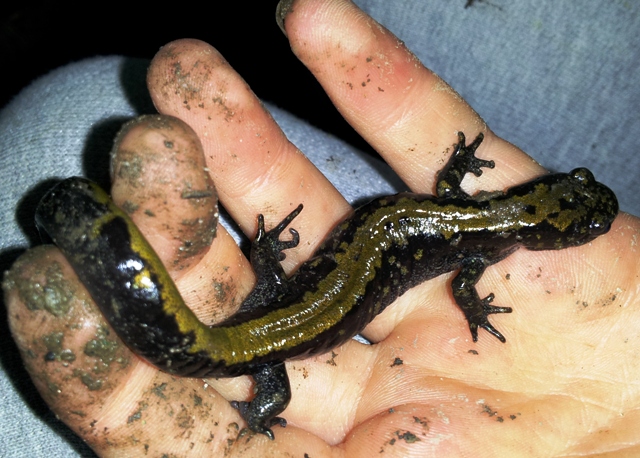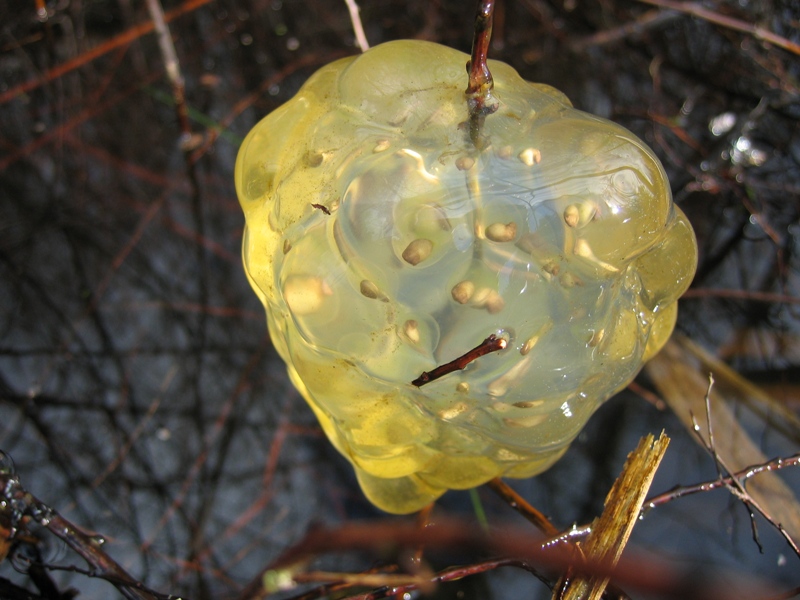If you find your flashlight and take a moonlit walk to one of Vashon’s forested ponds or wetlands tonight you might witness the incredible way nature celebrates Valentine’s Day. This may not be your partner’s idea of a typical romantic evening, but it will be interesting! Valentine’s night is smack in the middle of peak salamander mating season on Vashon. Look for wriggling pairs or groups of both northwestern and the less common long-toed salamanders in the dark shallows. Sometimes they can be found amorously clasped together just under the floating leaves at the edges of still waters.

Long-toed salamander (Ambystoma macrodactylum). Notice that one toe is longer than the others on the feet. Photo by: Tim DiChiara
These two species of native salamander (Ambystoma gracile and A. macrodactylum) are grouped together under the name mole salamanders because they spend the land-dwelling time of their year huddled under logs or in shallow rodent burrows in our forests. No one knows the exact cues they use to start mating. Seattle naturalist Stewart Wechsler thinks rainfall likely has something to do with it, and perhaps moon cycles. Whatever their reasons, around early to mid-February mole salamanders emerge from the forest at night and start to creep towards their breeding ponds. Here they spend a few dramatic nights wrestling for mates and mating. Mating season can last anywhere from 1 to 7 weeks depending on how fast the water temperature warms.

This Northwestern salamander (A. gracile) egg cluster was found in a survey by the author at Christensen Pond (2007). Photo by: Bianca Perla
After mating, the females lay eggs and attach them to submerged vegetation. The northwestern salamander lays grapefruit-sized clumps of eggs that she attaches to the branches of shrubs under the water. The eggs grow a thin film of algae that provides oxygen to the growing embryo. Long-toed salamander egg clusters are smaller than those of the northwesterns. These egg clusters are usually attached to submerged sticks.
Salamander Mermaids
When salamander larvae emerge from their eggs they look a bit like tadpoles with feathery gills protruding from their “cheeks.” Generally these larvae transform into adults and crawl out of their natal ponds by the end of the summer. However, some salamanders do not transform. Instead, they grow legs and grow to adult size while retaining their gills. These salamander mermaids and mermen stay in their water form for their entire lives and breed in this form as well. The technical term for this process of reaching sexual maturity in the larval life stage is neotony. The land form, or mature form salamanders, reach sexual maturity in 1 to 2 years and return to their breeding ponds only during the mating season.
Rough-skinned newts
Mole salamanders are less conspicuous than rough-skinned newts (Taricha granulosa), which you might also see breeding in these ponds on Valentine’s night. This is the very beginning of their breeding season which tends to peak in March or April. After mating, rough-skinned newts lay their eggs singly attached to submerged vegetation.
Rough-skinned newts are brownish orange with a bright-orange underside. They have a neurotoxin in their skin and they secrete larger amounts of this toxin when alarmed. This neurotoxin can be harmful, so wash your hands thoroughly if your skin contacts a newt’s skin, and do not ingest any of the toxins. Rough-skinned newts are so toxic they have nothing to fear, so they can be found migrating to their breeding ponds in broad daylight. Gartersnakes are the only known animal that can eat rough-skinned newts. Salamanders also carry this toxin, but at lower levels so they have more predators. Consequently, mole salamanders migrate at night.
On your forest walk you may also observe or hear red-legged frogs or Pacific chorus frogs. They have started to sing on the island already, which means breeding season is commencing for them as well. Pacific chorus frogs have a very recognizable song, whereas the red-leggeds’ low raspy sound is rarely heard. Both species lay eggs that could be confused with salamander or newt eggs because their breeding seasons overlap.
Places to see salamanders on Vashon
Good places to go to see our mating amphibians on this night of watery love: Christensen Pond and Lost Lake are the best bets. Around 30 years ago island residents report that rough-skinned newts, salamanders and frogs used to be seen crossing Wax Orchards road in droves in early spring. And Lost Lake’s original name was Lizard Lake named so in the early 1900s by neighborhood children because of the piles of salamanders they could find there.
Other places to see amphibians are Fisher Pond and the small pond east of Fisher off 115thAve. Islander Gary Shugart (of Slater Natural History Museum) has seen activity in some of the wet ditches near Fisher Pond along Bank Road, and at Mukai Pond in Island Center Forest. Any small ponds or ephemerally wet ditches or meadows, particularly ones with no bullfrogs, have the potential to be breeding areas for salamanders and frogs.
If you do find any mating salamanders, please let us know. Native amphibians seem to be in a general decline on Vashon, probably due to a variety of environmental factors including bullfrogs (which eat larvae and adults), hazardous road crossings, and atmospheric/weather changes. We’d like to get a better handle on who is left and where they are thriving, so please send us your reports: info@vashonnaturecenter.org.
Other ways to see salamanders
You can practice salamander voyeurism indoors with this video. And, if you need a refresher on what our salamander species look like, check out this video by a very enthusiastic 12-year old Canadian. He does a great job.
If you prefer a guided tour to watch salamanders, consider attending Salamander Love night at Camp Long, West Seattle offered by Seattle naturalist Steve Weschler–February 14th from 6:30-8:30 pm.
Spending a quiet, dark, and drizzly night with your loved one traipsing the shores of Vashon’s ponds reveals a whole new and wilder perspective on Valentine’s Day. Have fun, and let us know what you see!

Thank you for quoting me and linking to my website, and though you came pretty close, I thought I’d offer a correction on my name. It is Stewart Wechsler (not Steve Weschler). Also your quote sounds like a variation on what I’ve shared about what I heard were the cues for the Spotted Salamander, Ambystoma maculata, the Mole Salamander that I saw many of as a kid on Long Island, New York. I think I had been told that they came to their breeding ponds on the first rainy night after the first full moon in March. I don’t actaully know if its true. I imagine our local salamanders have day length as one of the cues that has them head to their breeding ponds if they aren’t neotenes that already live there. I thought I should also mention that, though they were popular, I haven’t offered my “Salamandar Love Night Programs” at Camp Long for a few years. I might do it sometime again in the future, but for now it is on hold. I used to work for Camp Long and the Seattle Parks Department, but now I’m totally independent, so logistics of entering the gated park at night, when I no longer have the gate key, up to now has discouraged me.